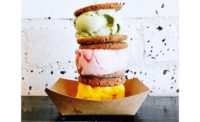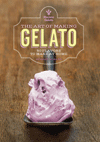There is no fun for ice cream processors
Ice cream is marketed to consumers as a “fun” food, but the industry sees little to enjoy. Sales of ice cream, novelties, and sherbets have declined. Frozen yogurt, on the other hand, is the category star.




Ice cream is a price-driven food with little brand loyalty. Sure, consumers say they have their favorite flavors and brands, but when that moment of truth arrives and it’s time to grab a carton from the freezer, price beats brand. The best-selling national brand is “private label.” And the sad truth of it is, Americans are buying less ice cream.
Ice cream does not carry a healthy halo or a nutritional benefit, unlike milk, cheese or yogurt. It’s a “fun” food and competes for share of stomach with cakes, pies and other desserts. Still, dairy processors tell Dairy Foods that they are addressing consumers’ health concerns by developing no-sugar added, gluten-free and lactose-free products.
In the 52 weeks ended Aug. 12, 2012, unit sales of ice cream fell 2.3% (to 1.13 billion units) compared to the previous period, according to SymphonyIRI, a Chicago-based market research firm. Thanks to an average 23-cent price increase, dollar sales of the dairy food increased 4.3% to $4.15 billion.
Other segments in the ice cream/sherbet category showed similar weakness:
• Frozen novelties, down 2.4% to 881.6 million units
• Sherbets/sorbets/ices, down 4% to 63.7 million units
• Frozen ice cream/ice milk desserts, down 23.8% to 17.6 million units
• Ice pop novelties, down 11% to 1 million units
The frozen yogurt/tofu segment, on the other hand, shone. Unit sales increased 10% to 63.1 million units and dollar sales rose 13.7% to $239.4 million. The average price increase was 12 cents per unit.
“Price is more important than brand, quality and health information which makes it difficult for brands to break away from a price promotion strategy, but it does give private label products a major opportunity for growth,” said John N. Frank, a food and drink analyst with Mintel, a Chicago-based market research firm.
Frank said that when consumers buy ice cream or other frozen novelties, 94% base their decision on flavor, 83% look at price and 72% look for a sale or promotion. When it comes to brand loyalty, slightly more than two-thirds (68%) of respondents make their selections based on brand alone.
According to Frank, new product development, new flavor profiles and ingredients, “better-for-you” products and new packaging concepts will be instrumental in the success of the category. Dairy Foods’ research and interviews bear him out. Ice cream manufacturers are at no loss for creativity. In 2012, they continued to introduce new flavors throughout the year, including limited-availability seasonal flavors. The tactic is meant to generate excitement in the ice cream aisle and spur shoppers to action.
Increasingly, dairy processors are looking at the bakery category for flavor inspirations. The “It” flavor has been red velvet cake.
“Traditional cakes, pies and other desserts often trigger other ice cream flavor ideas,” said Carl Breed, director of marketing for Brenham, Texas-based Blue Bell Creameries. “What starts out as a common dessert many times turns into a totally different ice cream concept.”
For example, Blue Bell this year introduced five flavors, four of which are bakery-inspired: Red Velvet Cake, Strawberry Banana Pound Cake, Summer Strawberry Pie and Southern Peach Cobbler. A fifth flavor, Rocky Mountain Road, was launched in Colorado. It did so well there that “we decided to open it up to our entire marketing area,” Breed said.
Stan Frankenthaler, the executive chef at Baskin-Robbins, also pointed to the cake flavor influence on ice cream. The Canton, Mass.-based ice cream retailer added red velvet to its line of mini ice cream cakes, called Cake Bites. Another new flavor is Apple Cinnamon Crisp, which incorporates apple and oat chunks.
Frankenthaler, who is also the vice president of innovation at Dunkin’ Brands, said there is an increase in sweet and salty flavor combinations. Baskin-Robbins addressed that trend with 3-Point Chocolate (a chocolate-flavored ice cream with a salty caramel ribbon and orange-colored caramel pretzel balls).
Eva Balazs of Perry’s Ice Cream, Akron, N.Y., said that pies, cakes, “nostalgic favorites, such as pudding, soda-shop-inspired flavors” all influence flavors. Balazs, Perry’s marketing and contract manufacturing manager, said sweet and salty combinations remain popular, as do seasonal and superfruit flavors. The company has a new flavor called Pretzelicious that blends vanilla ice cream, salty caramel swirls and chocolate-covered pretzel inclusions. It is sold in pints.
Perry’s theme this year is Simply America, which represents “fun flavors that consumers can afford and want to buy. We chose concepts with more natural declarations,” Balazs said.
She added that Perry’s, as much as it can, avoids artificial colors and flavors, high-fructose corn syrup and partially hydrogenated oils. It launched a new all-natural premium line this spring with Vanilla Bean, Chocolate, Chocolate Chip and Maple Walnut.
Pierre’s Ice Cream Co., Cleveland, created a new line to celebrate its 80th anniversary. Pierre’s Signature Ultimate Ice Cream includes Banana Fudge Chunk, Cherries & Chocolate Chunks and Exquisite Vanilla. Two bakery-inspired flavors in the line are Chocolate Lava Cake and Nun Better Better Snickerdoodle. The latter was inspired by the Sisters of the Holy Spirit in Cleveland. One of the nuns delivers cookies to Major League Baseball’s Cleveland Indians and gained popularity by appearing on TV. The snickerdoodle flavor is a tribute to Sister Mary Assumpta.
Other factors influencing ice cream production and packaging in the United States are the economy and the obesity epidemic. Single-serve packages act as calorie controllers. Processors also seek to limit calories with their no-sugar-added products. A weak economy keeps shoppers from buying as much ice cream as they were used to, and it has them looking for lower-priced options, like store brands or dairy desserts.
“We see them [consumers] buying smaller packages or fewer packages at one time,” said Craig Hall, general manager of Mars Ice Cream, Burr Ridge, Ill. Mars sells “mini” versions of Snickers, Twix, Milky Way and Dove ice cream novelties. “Each pack has 12 to 14 pieces, and each piece has between 60 and 90 calories, depending on the variety,” he said. A smaller size “allows consumers to control how many pieces they eat without sacrificing flavor.” It is also a “great” way to share an ice cream snack with “a lot of people at once,” he said.
Mars has tapped into a trend identified by Mintel. According to its survey of those who buy frozen treats, the container or serving size is important to 69% of respondents, and especially so among those age 18 to 24 (74%) who are the most likely to eat it away from the home directly after purchasing it from the grocery or convenience store.
Pierre’s Ice Cream has found that take-out and delivery restaurants (like pizza parlors) are installing in-store freezers to sell pints of ice cream, sherbet and frozen yogurt. “Pizza and Pierre’s go hand in hand,” said Matthew Thornicroft, the company’s assistant marketing and communications manager.
Gelato makers play the “better for you” card because their product contains less fat (it is made with milk, not cream). Dallas-based Talenti Gelato e Sorbetto calls its products “a healthier alternative.” Still, it loads peanut butter, chocolate chips and caramel into its new flavors this year. Among them are chocolate peanut butter cup (made with Belgian milk chocolate) and black raspberry chocolate chip.
Despite ice cream’s reputation as a treat and an indulgence, marketers are aware that consumers are looking for health claims. Mintel said that reduced fat (38%), reduced sugar (38%) and reduced calorie (36%) are the most important claims consumers are looking for on the packaging. Gluten-free and dairy-free products are rapidly growing in popularity, with 14% and 15% of Mintel respondents saying they are “very or somewhat important” to them.
Thornicroft called Pierre’s frozen yogurt products “an ideal low-fat alternative for consumers who enjoy treating themselves now and then. There’s also a big interest in lactose-free ice creams.” Pierre’s introduced a lactose-free premium product in vanilla and chocolate flavors in late 2011. It is finding more freezer space for its Yovation frozen yogurt with probiotics.
Do consumers know the difference between ice cream and dairy desserts? The Dairy Farmers of Canada say they don’t. In June and July, representatives from the organization handed out real ice cream in six Canadian cities. In a statement, Solange Heiss, DFC’s assistant director for marketing and nutrition communications, said “Real ice cream is made from milk. But in freezer aisles across Canada, ‘frozen desserts’ are masquerading as ice cream, fooling unsuspecting customers every day.”
Two U.S. ice cream processors said the same thing in informal conversations with Dairy Foods.
One dairy processor makes no bones about calling its new product a frozen dairy dessert. Straus Family Creamery, Petaluma, Calif., developed a dairy-based product called NuScoop. Vice president of sales and marketing Rich Martin likens it to “an energy bar for the ice cream category.”
NuScoop is a nutrient-laden food marketed as a healthy snack. A 4-ounce cup sells in stores for $2. Martin is also targeting the healthcare market where the food is positioned as an “occasional meal replacement.”
A 4-ounce serving delivers 6 grams of protein, 2 grams of dietary fiber and 25 vitamins and minerals. The certified-organic product is made with milk, agave, cane sugar, coconut oil, canola oil and oat fiber, among other ingredients. It is available in coffee, Dutch chocolate and strawberry flavors. NuScoop does not meet the standard of identity for ice cream because of its lower butterfat content and use of other ingredients.
Straus licenses the formula from NutriCopia, a company run by Ron and Arnie Koss, who started the Earth’s Best company.
Frozen yogurt
Frozen yogurt is the star of the frozen dessert category. Mintel cites the popularity of Greek yogurt spilling over into the ice cream and frozen novelty market. It said total U.S. retail sales of frozen yogurt were up 9.7% from 2011 to 2012. That is the highest growth percentage of the four ice cream and frozen novelty segments. SymphonyIRI clocks the growth even higher. Sales rose 13.7% to $239.4 million (see tables), according to SymphonyIRI.
The demand is confirmed by a survey of members of the International Ice Cream Association (which make 85% of the products eaten in the United States). The survey found that 52% of IICA members see an increased demand for frozen yogurt.
In October, General Mills’ Yoplait brand came out with pints and stick novelties of frozen yogurt and Greek frozen yogurt, manufactured by Wells Enterprises, Le Mars, Iowa. The flavors in the Yoplait Original Frozen Yogurt pints are: strawberry, peach, strawberry banana, cherry, blueberry, vanilla and mixed berry.
Earlier in the year, Orrville, Ohio-based Dairy Enterprises added a low-fat Greek frozen yogurt to its Ruggles line. It sells pints and single-serve 4-ounce cups in original tart, vanilla bean, honey and three fruit flavors.
Balazs of Perry’s Ice Cream said health and wellness is an opportunity for growth in the frozen dessert category. “Consumers are looking for healthier ways to indulge and care about the ingredients used in the products they purchase. Better-for-you products and portion-controlled packaging, all-natural, gluten-free, dairy-free and frozen yogurt will be opportunities in our category poised for growth.”
Frozen novelties
Trends in ice cream, including portion control and frozen yogurt, carry over into novelties. Wells Enterprises developed a line of snack-sized cones for its Champ! brand. The smaller chocolate-coated sugar cone is filled with chocolate or vanilla ice cream topped with peanuts. It also created snack-sized ice cream bars under the Sweet Freedom brand. These treats contain 150 calories (or fewer) per serving, 8 grams of fat and 30 grams or fewer of carbohydrates.
In April, Unilever, Englewood Cliffs, N.J., combined frozen yogurt with its Popsicle novelty to create the Yosicle, made with 10% nonfat yogurt. The company described it as “an excellent source of calcium per two-pop serving.” The Yosicle is sold in four varieties flavors and three shapes (Torpedo, Layerz and Duos).
Dreyer’s Grand Ice Cream, Oakland, Calif., added a mango flavor to its fruit bars. The unit of Nestle USA also brought out 12-count packs of coconut, pineapple and orange flavors. The fruit bars contain from 50 to 80 calories per serving.
Ice cream processors also tap into consumers’ love of popular candy brands. Wells Enterprises rolled out four varieties of Blue Bunny ice cream bars coated with chocolate from Cadbury UK. The flavors are Caramello, double chocolate, vanilla chocolate and chocolate almond.
Popsicle partnered with Kraft Foods’ Sour Patch Kids candy brand on ice pops that replicate the sour-then-sweet taste of the candy. Each ice pop has a sour ice shell and a sweet ice center, and is available in lime, raspberry and orange.
Also tapping into extreme flavors was Blue Bell Creameries, which introduced four frozen novelties this year to its all-natural fruit bar line. The flavors are coconut, cotton candy, sour green apple and banana.
“Cotton candy, sour pops and banana pops are all designed for kids,” said Breed. “They all taste great but are low in fat. The sour pops are made with real fruit juice.”
Developing flavors and formats for a younger generation might be the ticket to ensure the long-term success of ice cream processors. Manufacturers say ice cream purchases decline with the age of the buyer. That does not bode well for the category. As more baby boomers turn 65, they might forgo the scoop of ice cream with their slice of birthday cake.
Ice Cream Processors
Are Talking About:
• Bakery-inspired flavors, like snickerdoodle and
apple crisp
• Frozen dairy dessert masquerading as ice cream
• Making “better for you” formulas
• A renaissance in frozen yogurt
Restaurants add ice cream to their menus
By Mary Chapman, Technomic Inc.
Consumers indicate that they don’t eat ice cream as much as they used to, likely tempted by other sweet treats and a growing number of snack options at restaurants and retail. About three out of five of consumers (59%) say they eat ice cream or other frozen desserts as a snack at home, a figure that is down from 75% in 2010.
Nevertheless, Technomic’s MenuMonitor online trend-tracking resource, which analyzes the menus of more than 1,200 top chains, emerging concepts and leading independent restaurants, finds the number of desserts with ice cream is 1,996 in second-quarter 2012, up 2% from 1,966 in 2011. Ice cream desserts are available at 556 concepts, up from 551 in 2011.
Technomic data also finds:
• Vanilla is offered most often; 41% of ice cream desserts on menus are described as vanilla; 34% chocolate; 19% fudge. Rounding out the top five flavors are caramel and strawberry.
• Of ice cream desserts menued in 2012, 48 items make the claim of being gluten-free, which is just over 2%. Only 1% of items are described as “natural.”
• On The Border Mexican Grill & Cantina added the Border Brownie Sundae, with a chocolate and walnut brownie topped with vanilla ice cream and pecan praline sauce. T.G.I. Friday’s created the Mandarin Dream, made with Cointreau orange liqueur, an orange sherbet and vanilla ice cream shake, Mandarin oranges and whipped cream.
• MenuMonitor finds the number of adult beverages featuring ice cream is up 16%, to 73 from 63. Thirty-nine concepts are offering them, up from 33 in 2011.
— Mary Chapman is the director of product innovation
at Technomic Inc., Chicago.
Looking for a reprint of this article?
From high-res PDFs to custom plaques, order your copy today!






.png?height=200&t=1663254269&width=200)


